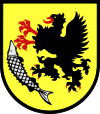Szczecinek
| Szczecinek | |||
|---|---|---|---|
|
Panorama of the town | |||
| |||
 Szczecinek | |||
| Coordinates: 53°43′N 16°41′E / 53.717°N 16.683°ECoordinates: 53°43′N 16°41′E / 53.717°N 16.683°E | |||
| Country |
| ||
| Voivodeship | West Pomeranian | ||
| County | Szczecinek County | ||
| Gmina | Szczecinek (urban gmina) | ||
| Established | 1310 | ||
| City rights | 1310 | ||
| Government | |||
| • Mayor | Jerzy Hardie-Douglas | ||
| Area | |||
| • Total | 48.63 km2 (18.78 sq mi) | ||
| Population (2010) | |||
| • Total | 40,211 | ||
| • Density | 830/km2 (2,100/sq mi) | ||
| Time zone | CET (UTC+1) | ||
| • Summer (DST) | CEST (UTC+2) | ||
| Postal codes | 78-400, 78-401, 78-402, 78-403, 78-404, 78-410 | ||
| Area code(s) | +48 94 | ||
| Car plates | ZSZ | ||
| Website | http://www.szczecinek.pl | ||
Szczecinek (Polish pronunciation: [ʂt͡ʂɛˈt͡ɕinɛk]; German: Neustettin; Kashubian: Nowé Sztetëno) is a city in Middle Pomerania, northwestern Poland with a population of more than 40,000 (2011). Formerly in the Koszalin Voivodeship (1950–1998), it has been the capital of Szczecinek County in the West Pomeranian Voivodeship since 1999. It is an important railroad junction, located along the main Poznań - Kolobrzeg line, which crosses less important lines to Chojnice, Słupsk and Runowo Pomorskie. The city boundaries were expanded in 2009 to include Świątki and Trzesieka, a total area of 48.63 km2 (18.78 sq mi).
Location
Szczecinek lies in eastern part of West Pomeranian Voivodeship. It is located on the border of Pojezierze Szczecineckie and Pojezierze Drawskie. Historically, it was included within Western Pomerania. In 2010, the city boundaries were with the following villages in Gmina Szczecinek: Gałowo, Marcelin, Godzimierz, Turowo, Parsęcko, Buczek and Zółtnica.
History and etymology
In 1310, the castle and town was founded under Lübeck law by Duke Wartislaw IV of Pomerania-Wolgast and modelled after Szczecin (German: Stettin) which is situated about 150 km (93.21 mi) to the west. The initial name was "Neustettin" (Polish: Nowy Szczecin, German: Neustettin, Latin: Stetin Nova). It was also known as "Klein Stettin" (Polish: Mały Szczecin, German: Klein Stettin). In 1707 the town was known in Polish as Nowoszczecin, while the Mały Szczecin name gradually developed into the modern name Szczecinek.[1] The town was fortified to face the Brandenburgers, with a wall and palisades. In 1356 Neustettin was hit by the plague. Thankful for their survival, the Dukes Bogislaw V, Barnim IV and Wartislaw V founded the Augustine monastery Marienthron, on the Mönchsberg on the southern bank of Lake Streizigsee. Under the Duke Wartislaw VII Neustettin, from 1376 to 1395 it was the seat of his Duchy. Afterwards, it was ruled by Pomeranian Duchy: Rügenwalde (-1418), Wolgast (-1474) and Stettin (until 1618).
On 15 September 1423, the "great day of Neustettin", the Pomeranian dukes, the Hochmeister of the Teutonic Order and Nordic king Eric VII of Denmark met to discuss defense against the union of Brandenburg and Poland. In 1461 Neustettin was sacked, looted and burned by Polish troops and Tatars because King Casimir IV wanted to take revenge on Eric II of Pomerania-Wolgast who supported the Teutonic Knights.
At the end of the Thirty Years War, Neustettin became part of Brandenburg, and in 1701 under the crown of Prussia. In 1945, the Red Army occupied the town and put it under Polish administration.
A dangerously low flight was performed by a Polish Su-22 in the town on 6 August 2012; this incident is under investigation.[2]
Education

- Wyższa Szkoła Kupiecka in Łódź, branch in Szczecinek
- Duchess Elizabeth Secondary School
- Vocational Schools of Economics in Szczecinek
- Vocational Technical Schools in Szczecinek
- Vocational Schools Agriculture in Świątki.
Major corporations
- Grupa Kronospan SA
- KPPD Szczecinek SA
- Elmilk Sp. z o.o.
Historical population
1940: 19,900 inhabitants (mostly Germans)
1945: 11,800 inhabitants (8,300 Poles and 3,500 Germans)
1950: 15,100 inhabitants (mostly Poles)
1960: 22,800 inhabitants
1970: 28,700 inhabitants
1975: 32,900 inhabitants
1980: 35,700 inhabitants
1990: 41,400 inhabitants
1995: 42,300 inhabitants
2000: 38,928 inhabitants
Notable residents
- Eckart Afheldt (1921–1999), general
- Gustav Behrend (1847–1925), dermatologist
- Lothar Bucher (1817–1892), publicist
- Artur Bugaj (b. 1970), footballer
- Eberhard Heder (b. 1918), Captain in the Waffen-SS during World War II, recipient of the Knights Cross of the Iron Cross
- Hans Krüger (1902–1971), politician
- Ewa Minge, fashion designer
- Małgorzata Ostrowska (born 1958), singer
- Herbert Panknin (1913-2001), German Kriegsmarine officer
- Abraham Springer, great-grandfather of TV presenter Jerry Springer, was a prominent member of the town's Jewish community who launched an unsuccessful attempt to sue agitator Dr Ernst Henrici in 1881, claiming that an inflammatory anti-semitic speech in the town led directly to the burning down of the synagogue on 18 February of that year.[3]
- Aleksander Wolszczan (b. 1946), astronomer
International relations
Twin towns — Sister cities
Szczecinek is twinned with:
References
- Notes
External links
| Wikimedia Commons has media related to Szczecinek. |
- Szczecinek Regional Portal
- The military su-22 in the center of the town (picture taken from the "Temat Szczecinecki" news paper office
| |||||||||||||||||



